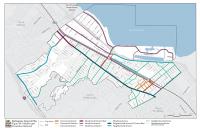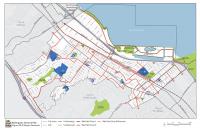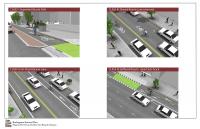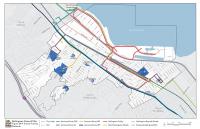Multimodal Transportation Network
An efficient, accessible, and safe multimodal transportation network moves people and goods through the community. In addition to their utilitarian function of moving vehicles, streets can also provide spaces for people to exercise, gather, and conduct business. Burlingame’s streets serve many functions, including:
- Allowing people to move about town
- Providing access to businesses, homes, schools, parks, and public spaces
- Supporting adjacent land uses and developments
- Providing safe, attractive areas that encourage personal interactions
- Promoting human and environmental health by making it easier and safer to travel by transit, by bicycle, or on foot
Public rights-of-way (roadways, sidewalks, trails, and paths) cover a significant part of any community, generally occupying 20 to 30 percent of a community’s total land area. The layout and use of these areas influence many aspects of the physical environment, including how people move, how people and goods get to homes and businesses, and how frequently people walk, bike, and exercise outdoors. Street and pathway designs also affect the safety and independence of people in the community, especially vulnerable populations such as children, persons with disabilities, and the elderly. A well-planned and well-designed mobility network is a means to realize the community’s goals for improved health, economic growth, quality of life, and fiscal soundness.
With these goals in mind, Burlingame aims to develop a complete multimodal transportation network (Complete Streets network). This network will be designed to encourage people to use non-automobile modes for as many trips as possible, as high use of these alternative modes enables the system to move more people with less delay, cost, and environmental impacts. However, tradeoffs need to be made within each mode to allow safe access for all other modes. Streets are where walking, bicycling, transit, private vehicles, and freight come together to provide mobility to their respective users.
Street Classifications
Streets and sidewalks are public spaces that serve many functions: mobility corridors, connections to businesses, places for interaction among neighbors, and even facilities for managing stormwater control. Above all, the primary function is mobility, and different street types accommodate different means of moving about. The City of Burlingame’s street classification system is shown in Figure M-1. It provides a framework for street design and mobility that supports all of these functions and meets the City’s needs for 21st century transportation options.
The street classification system establishes and promotes the suitability of streets to accommodate various travel modes and land uses. In particular, this system is sensitive to local context, land use, built form, and mobility priorities. Each of the classifications aligns with Federal Highway Administration (FHWA) categories, as shown in Table M-1. However, they encompass a more dynamic range of uses than those identified by FHWA. A detailed description of Burlingame’s street classifications and their corresponding FHWA category are shown in Table M-2.
Street uses are independent of their normal form and function, such as routes for emergency vehicles, streets adjacent to major transit stations or school zones, and bicycle priority streets. These uses do not necessarily dictate the specific design of a street but instead encourage design flexibility to better serve the specific purposes. For example, the local access streets that can best serve bicycles should be clearly identified so their roadway and intersection design emphasizes bicycle priority and comfortable access. Similarly, emergency routes may require width and design exceptions to accommodate movements of emergency vehicles; for example, where a roundabout is appropriate for a particular intersection, its edges may need to be rounded so that large fire trucks can roll over rather than have to swerve around them.
| Classification | Arterial | Collector | Local |
|---|---|---|---|
| El Camino Real | X | ||
| Major Connector | X | X | |
| Minor Connector | X | ||
| Access | X |
| Classification | Description | Example | FHWA Category |
|---|---|---|---|
| Commercial Arterial | Street with commercial frontages with capacity to serve as a main route for multiple modes Distributes trips to commercial areas and provides a balanced level of service for vehicles, transit, bicycles, and pedestrians, wherever possible. Pedestrian improvements are comfortable to walk along and provide safe crossings at designated locations. |
Howard Ave (west of California Drive) | Arterial |
| Major Connector |
Street with commercial frontages with capacity to serve as a minor route for multiple modes |
X | |
| Commercial Collector |
Street with commercial frontages with capacity to serve as a minor route for multiple modes
|
Burlingame Avenue | Collector |
| Commercial Access |
Low-volume commercial street serving local traffic |
Highland Avenue | Local |
| Mixed Use Arterial, El Camino Real |
El Camino Real, regional access corridor with mixed residential and commercial frontages and capacity to serve as a main route for multiple modes |
El Camino Real (north of Rosedale Avenue) | Arterial |
| Mixed Use Arterial |
Street with mixed use frontages with capacity to serve as a main route for multiple modes |
Rollins Road | Arterial |
| Mixed Use Collector |
Street with mixed use frontages with capacity to serve as a minor route for multiple modes |
Adrian Boulevard | Collector |
| Mixed Use Access |
Low-volume mixed use through street serving local traffic |
Malcolm Road | Local |
| Neighborhood Arterial, El Camino Real |
El Camino Real, regional access corridor with residential frontages and capacity to serve as a main route for multiple modes |
El Camino Real (south of Rosedale Avenue) | Arterial |
| Neighborhood Arterial |
Primarily residential streets with capacity to serve as a main route for multiple modes |
Trousdale Drive (West of Ogden Drive) | Arterial |
| Neighborhood Collector |
Primarily residential streets with capacity to serve as a minor route for multiple modes |
Hillside Drive | Collector |
| Neighborhood Access |
Low-volume residential street serving mostly local traffic |
Paloma Avenue | Local |
The following goal and policies provide a framework for ensuring that network changes and improvements over time are accomplished in such a way that reduces conflicts and congestion and promotes community health and sustainability.
Goal: M-1
Achieve and maintain a citywide circulation network that provides safe, efficient, and convenient mobility for all users and modes of transportation



